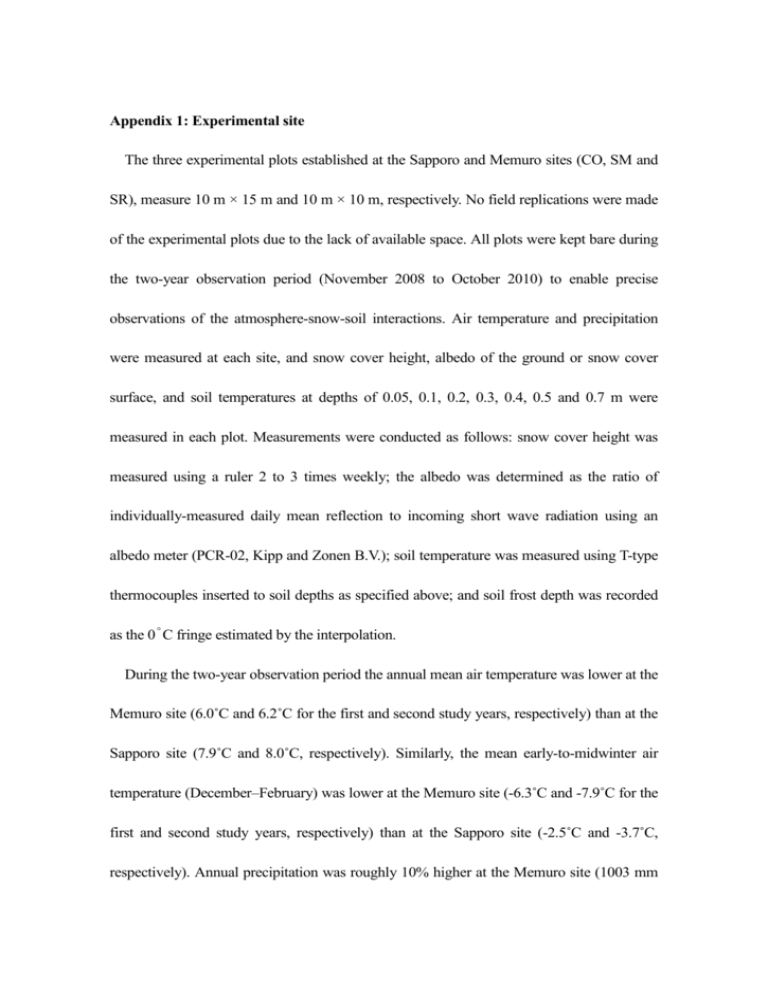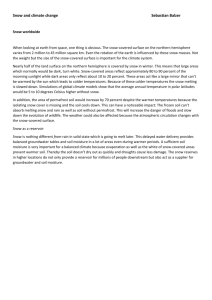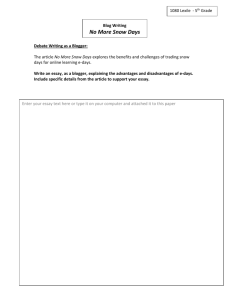Appendix 1: Experimental site The three experimental plots
advertisement

Appendix 1: Experimental site The three experimental plots established at the Sapporo and Memuro sites (CO, SM and SR), measure 10 m × 15 m and 10 m × 10 m, respectively. No field replications were made of the experimental plots due to the lack of available space. All plots were kept bare during the two-year observation period (November 2008 to October 2010) to enable precise observations of the atmosphere-snow-soil interactions. Air temperature and precipitation were measured at each site, and snow cover height, albedo of the ground or snow cover surface, and soil temperatures at depths of 0.05, 0.1, 0.2, 0.3, 0.4, 0.5 and 0.7 m were measured in each plot. Measurements were conducted as follows: snow cover height was measured using a ruler 2 to 3 times weekly; the albedo was determined as the ratio of individually-measured daily mean reflection to incoming short wave radiation using an albedo meter (PCR-02, Kipp and Zonen B.V.); soil temperature was measured using T-type thermocouples inserted to soil depths as specified above; and soil frost depth was recorded as the 0˚C fringe estimated by the interpolation. During the two-year observation period the annual mean air temperature was lower at the Memuro site (6.0˚C and 6.2˚C for the first and second study years, respectively) than at the Sapporo site (7.9˚C and 8.0˚C, respectively). Similarly, the mean early-to-midwinter air temperature (December–February) was lower at the Memuro site (-6.3˚C and -7.9˚C for the first and second study years, respectively) than at the Sapporo site (-2.5˚C and -3.7˚C, respectively). Annual precipitation was roughly 10% higher at the Memuro site (1003 mm and 1183 mm for the first and second study years, respectively) than at the Sapporo site (910 mm and 1043 mm, respectively), whereas cumulative early-to-midwinter precipitation was lower at the Memuro site (152 mm and 132 mm for the first and second study year, respectively) than at the Sapporo site (269 mm and 190 mm, respectively). The maximum snow cover height at the CO and SM plots was 0.86 and 0.79 m at the Sapporo site, and 0.72 and 0.69 m at the Memuro site in the first and second study years, respectively (Fig. 2). The application of charcoal onto the snow cover as an ASA in the SM plots caused a decline in the albedo of the snow cover surface from 0.7-1.0 to 0.2-0.4, and enhanced the process of snowmelt, particularly at the Memuro site. Snowmelt was completed 14 and 10 days earlier in the SM plot (in comparison with the respective CO plot) at the Memuro site in the first and second study year, respectively, but 6 and 3 days earlier at the Sapporo site in the respective years. Except for the Memuro site in the first study year, several snowfall events occurred after the ASA application and negated the decrease in albedo (data not shown). Despite the unexpected snowfall, the albedo decreased again immediately after the snow covering the ASA had melted, and finally snowmelt was stimulated to a maximum extent. In the SR plots snow cover height was occasionally below 0.2 m, and thus reduced successfully by the operations (Fig. 2). At both sites, the annual maximum soil frost depth at the CO and the SM plots ranged from 0.0 m to 0.15 m. However, the results were not the same for the SR plot where depths exceeded 0.2 m: at the Memoru site depths of 0.42 m and 0.53 m were recorded in the first and second study year, respectively; and at the Sapporo site depths of 0.21 m and 0.27 m were recorded. The maximum soil frost depth was observed in February at both sites. Appendix 2: Measurement of CO2 and N2O fluxes of soil A circular stainless steel collar (275 mm OD) with a water groove (20 mm in height) was embedded at the center of the subplot (2 m × 2 m), and potassium nitrate was supplied therein at a rate of 50 kg N ha-1 during late October 2008 and 2009 to mimic the excess residual mineral N level in local farmlands after harvest. Chambers made of colored polyvinylchloride measuring 0.25-m in diameter, 0.40 m in height, and 19.6-L in volume were used to observe the net N2O and CO2 emission rates. Air samples drawn from the chamber headspace at 1, 11, 21 and 31 min after the onset of measurements, were individually injected into a pre-evacuated 20-mL vial capped with a butyl rubber septum or a pre-evacuated 150-mL Tedlar® bag. The N2O concentration was determined using a gas chromatograph (Shimadzu 14B, Shimadzu Co. Ltd, Japan) equipped with an electron capture detector, whereas the CO2 concentration was determined using an infrared analyzer, (ZFP9, Fuji Electric), or gas chromatograph (GC-14B, Shimadzu) equipped with a thermal conductivity detector. Emission rates (μg N m-2 h-1 and mg C m-2 h-1) were derived as the slope of a linear regression computed for measured N2O and CO2 concentration data in the chamber versus time (ppm h-1). To keep the area between the chamber and the ground surface airtight, the groove on the collar was filled with liquid water as a seal. However, during the period when the collar was under the snow cover, the chamber was placed directly onto the snowpack surface to minimize any disturbance of the snow cover height. At that time, the quality of the air-tightness between the chamber and the snowpack surface was uncertain; therefore, the slope values were statistically tested as shown in Yanai et al. (2011). Any slope that did not differ significantly from 0 (Student’s t-test, α = 0.20, thus p ≥ 0.10) was regarded as 0 ppm h-1, i.e., no net gas emissions occurred. The gas sampling was carried out at two- to three-day intervals during the snowmelt period (March–early April) and weekly for the remainder of the time. Cumulative emissions over the monitoring period (kg N ha-1 and Mg C ha-1) were calculated by linear interpolation of the observed emission rates. In addition, the CH4 flux was not measured because of its negligibly small contribution to the total greenhouse gas balance in an arable upland field (Koga et al. 2004; Koga et al. 2006), and it was not known whether the CH4 flux responded significantly to the seasonal freeze-thaw conditions of soil (see Flessa et al. 1995; Maljanen et al. 2007). ESM Table 1 Local snow cover manipulation techniques conducted in agricultural fields in Hokkaido, northern Japan. Main obj ective Means Timing to do snow cover height air temperature Acceleration of snowmelt *extention of the growing season for crop plants *alleviation of the damage from snow mold application of blackish powders onto snow cover surface early spring over 0.5 m over 0 ˚C; daily mean Soil frost control *frost-kill of unharvested potato tubers in soil removal and re-accumulation of snow cover early to mid winter over 0.2 m below 0 ˚C; daily maximum ESM Table 2 Physico-chemical properties of wood-based waste charcoal† used as an agricultural snowmelt agent. Moisture Total Carbon Total Nitrogen P2O5 CaO MgO K 2O Fe Mn Zn Cu pH (1:2.5) EC (1:5) SSA ‡ Values shown are on an oven-dry basis † : dark 4 mm-granular, pyrolysis at 800°C ‡ : Specific surface area, N2 as sorbent g kg -1 g kg -1 g kg -1 g kg -1 g kg -1 g kg -1 g kg -1 g kg -1 mg kg -1 mg kg -1 mg kg -1 dS m -1 m 2 g -1 250 922 8.5 1.16 15.0 2.86 7.01 1.47 258 29.3 50.9 9.5 2.11 54 ESM Fig. 1 Schematic diagram of N2O flux in early spring affected by seasonal soil-freezing and insulation of soil from cold air during the snow-melting period. Modified from Yanai et al. (2012) References Flessa H, Dörsch P, Beese F (1995) Seasonal variation of nitrous oxide and methane fluxes in differently managed arable soils in southern Germany. J Geophys Res 100: 23115–23124 Koga N, Sawamoto T, Tsuruta H (2006) Life cycle inventory-based analysis of arable land farming systems in Hokkaido, northern Japan. Soil Sci Plant Nutr 52: 564–574 Koga N, Tsuruta H, Sawamoto T, Nishimura S, Yagi K (2004) N2O emission and CH4 uptake in arable fields managed under conventional and reduce tillage cropping systems in northern Japan. Glob Biogeochem Cycle 18: GB4025 Maljanen M, Kohonen AR, Virkajärvi P, Martikainen PJ (2007) Fluxes and production of N2O, CO2 and CH4 in boreal agricultural soil during winter as affected by snow cover. Tellus 59B: 853–859 Yanai Y, Nemoto M, Iwata Y, Hirota T (2012) Possible processes of N2O production and emission on seasonally frozen soil. Low Temp Sci 70: 145–151 (in Japanese, English abstract)





